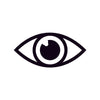RIGHT SELECTION OF FRAMES BASED ON YOUR PRESCRIPTION
We have a whole plethora of frames to choose from nowadays, with every colour and shape so it can be challenging to find the best selection of eyeglass frames for your prescription. However, if your prescription is complex, choosing the wrong frame in terms of horizontal size and vertical depth can be disastrous, and will not give you long term benefits.
Here are some guidelines for complex prescriptions:
1. Being short-sighted
If you are quite shortsighted (perhaps over -4.00), it is important to choose something horizontally narrow, so that the sides of the lenses on the outer side of your face (the temporal side) will not stick out too much. If the distance between your eyes, called the pupillary distance or PD is narrow (below 60mm) then you have to be ultra conservative in this approach as someone else with the same prescription but a bigger PD (probably above 65mm) will have a thinner lens due to the decentration of the lens.
Best options: narrow acetate or plastic frames – so the thickness of the frame can mask the thickness of the lenses.
Best to avoid: rimless or half rim – as the edge of the lens is exposed, making the lenses appear thicker.
Best lens options: high index lenses – compressed to be thinner.
2. Being long-sighted
If your prescription is around +3.00 or more, be very careful on your frame selection.
Best options: acetate or plastic frames – fully enclosed and also metal frames.
Best to avoid: half rim frames or metal inline frames as the lens thickness has to be thicker on the edge so that lenses don’t pop out.
Best lens options: aspheric high index lenses. Ground – the lens diameter is smaller so the lenses are thinner. Aspheric will also make the magnification of the lenses less than normal spherical, reducing the “bug eye” effect.


